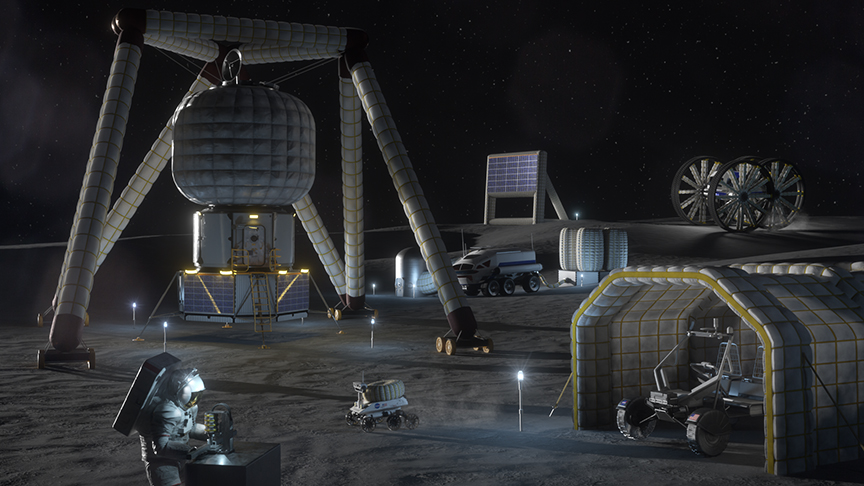
U-M Student Team to Help Fill the Inflatable Void in NASA Challenge
A student team at the University of Michigan is selected to build a design in NASA’s BIG Idea Challenge.

A student team at the University of Michigan is selected to build a design in NASA’s BIG Idea Challenge.
This year will be a “BIG” year for many college and university teams, including a team of student engineers at the University of Michigan, as they research, design, and demonstrate novel inflatable systems configured for future lunar operations through a NASA-sponsored engineering competition.
NASA’s Breakthrough, Innovative and Game-Changing (BIG) Idea Challenge asked student innovators to propose novel inflatable component and system concepts that could benefit future Artemis missions to the Moon and beyond.
The Inflatable Systems for Lunar Operations theme allowed teams to submit various technology concepts such as soft robotics, deployable infrastructure components, emergency shelters or other devices for extended extravehicular activities, pressurized tunnels and airlocks, and debris shields and dust protection systems. Inflatable systems could greatly reduce the mass and stowed volume of science and exploration payloads, critical for lowering costs to deep-space destinations.
Award values vary between about $100,000 and $150,000 and are based on each team’s prototype and budget. The 2024 BIG Idea Challenge awardees include the Cargo-BEEP Team at the University of Michigan in Ann Arbor, under the direction of Advisor John Shaw.
The Cargo-BEEP (Cargo Balancing Expandable Exploration Platform) team at U-M proposed to design a two-wheeled inflatable vehicle, with the ability to autonomously navigate the lunar surface to assist astronauts in carrying cargo, either following astronauts during excursions or transporting supplies between locations. Cargo-BEEP is light and compact, expanding from a small cylinder. The vehicle would operate similarly to a Segway in principle and could be mounted on rovers or even on astronauts’ suits while in compact form.
Once funded, finalist teams will continue designing, building, and testing their concepts, which could lead to NASA innovations that augment technology currently in development. Work performed by the teams culminates in a final technical paper, prototype demonstration, and potential opportunity to present in front of a diverse panel of NASA and industry experts.
As a program affiliated with NASA’s Lunar Surface Innovation Initiative (LSII), the BIG Idea Challenge incubates new ideas from the future workforce. Through the challenge, student teams aid LSII’s mission to advance transformative capabilities for lunar surface exploration across NASA’s Space Technology portfolio.
“We truly love engaging with the academic community and incorporating the students’ novel ideas into our approaches to technology development. We need cutting-edge and groundbreaking technologies for successful space exploration missions, so it’s important that we continue to push the envelope and ignite innovation. I can’t think of a better way to do that than collaborating with bright, creative minds who will comprise our future workforce,” said Niki Werkheiser, Director of Technology Maturation at NASA.
Since its inception in 2016, the challenge has invited students to think critically and creatively about several defined aerospace topics, including extreme terrain robotics, lunar metal production, Mars greenhouse development, and more. Each year, the theme is tied directly to a current aerospace challenge NASA is working on.
“Through the BIG Idea Challenge, we enhance the university experience by providing students and faculty with more opportunities to engage in meaningful NASA projects. This not only enables a multitude of networking opportunities for the students but also gives them a real sense of accomplishment and lets them know that their ideas are important,” said Tomas Gonzalez-Torres, NASA’s Space Grant project manager.
The BIG Idea Challenge is one of several Artemis student challenges sponsored through NASA’s Space Technology Mission Directorate’s Game Changing Development (GCD) program and the agency’s Office of STEM Engagement Space Grant Project. It is managed by a partnership between the National Institute of Aerospace and The Johns Hopkins Applied Physics Laboratory.
BIG Idea supports GCD’s efforts to rapidly mature innovative and high-impact capabilities and technologies for possible infusion in future NASA missions, while creating a rewarding student and faculty experience. The 16-month intensive project-based program supports innovations initiated and furthered by the student teams that can possibly be adopted by NASA, and it works to endeavor ambitious new missions beyond Earth.
